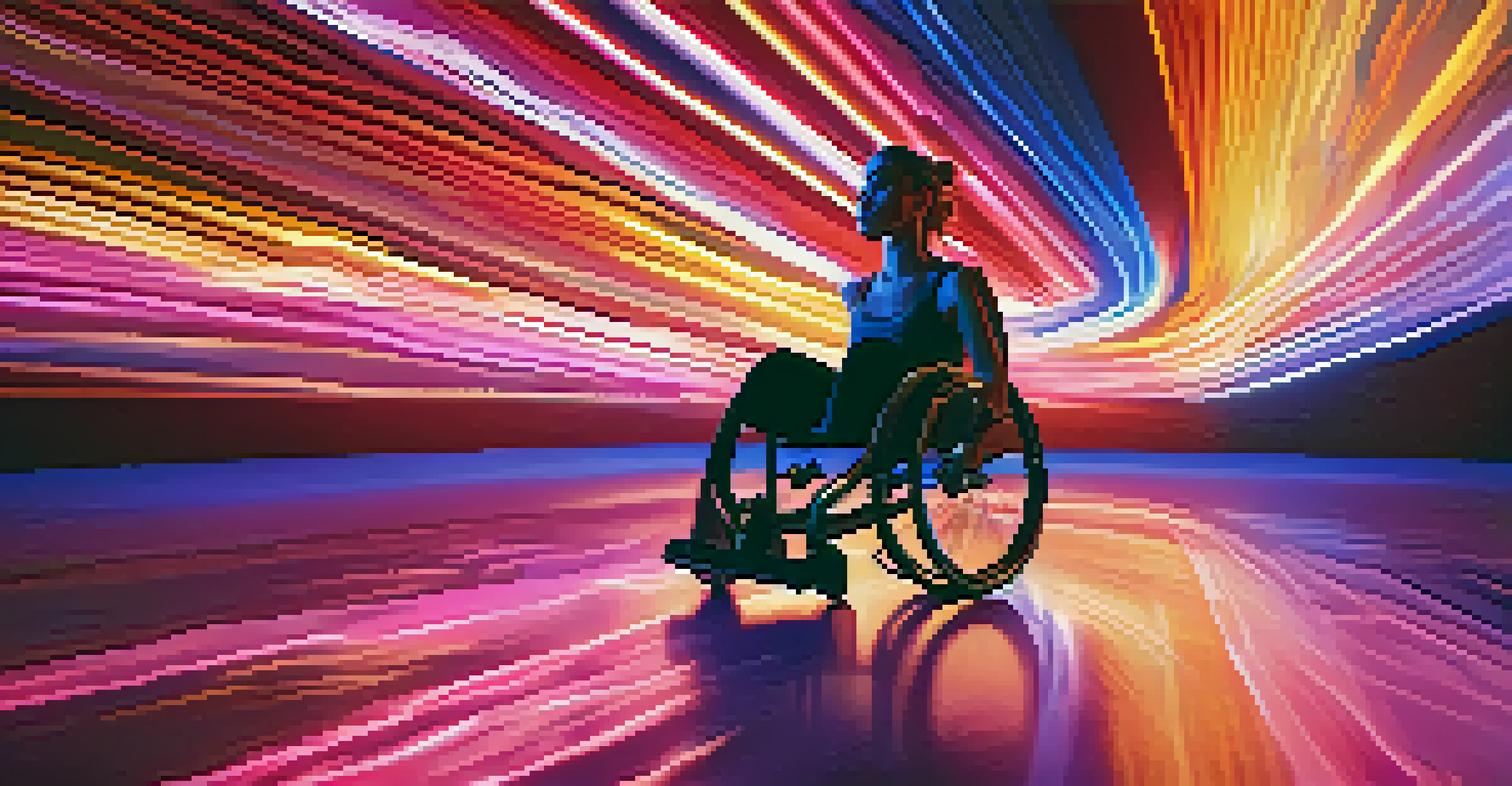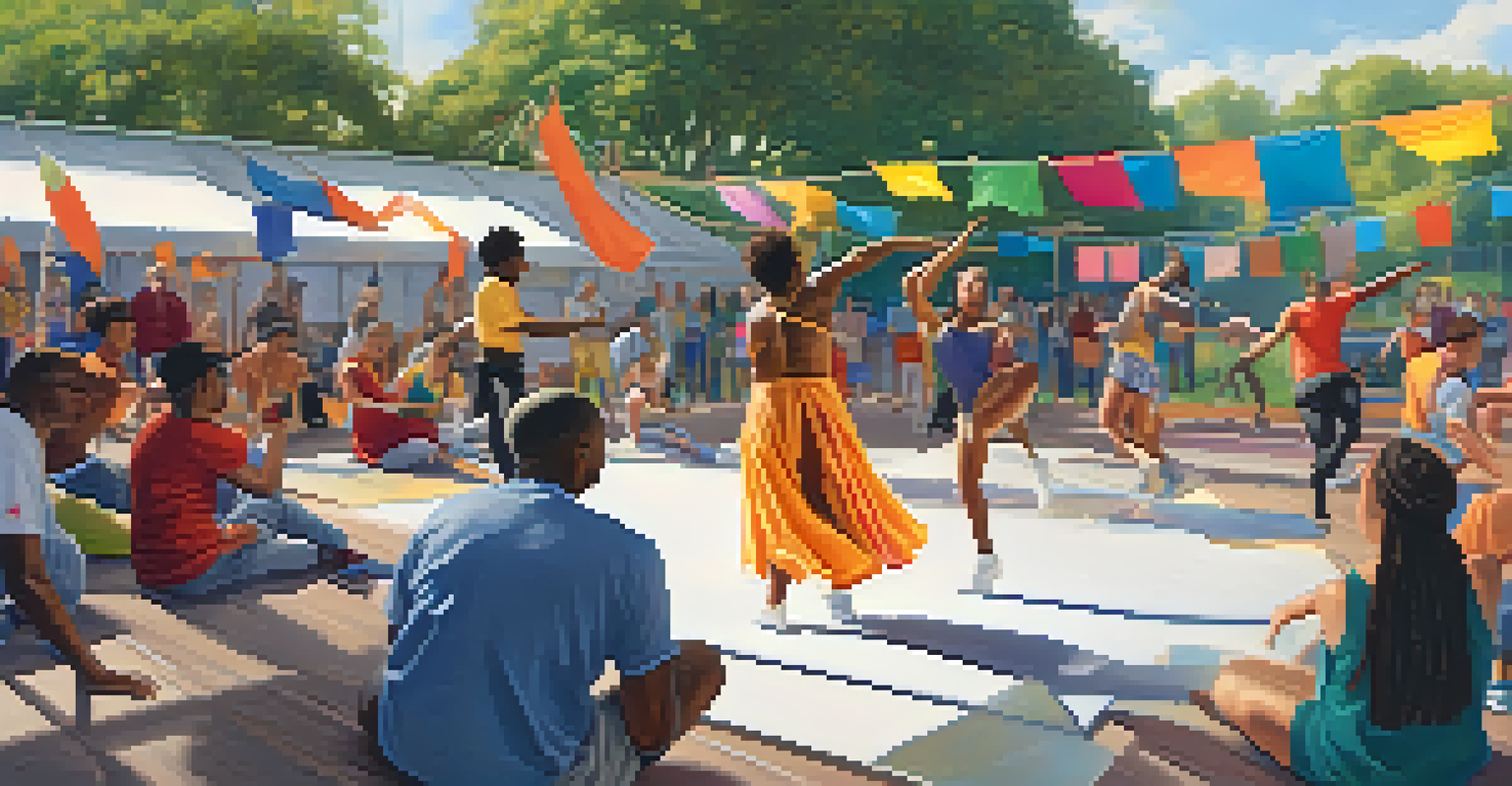The Role of Technology in Adaptive Dance Performances

Understanding Adaptive Dance and Its Importance
Adaptive dance is a form of movement expression designed to cater to individuals with varying abilities and needs. It provides a unique platform for self-expression, allowing dancers with disabilities to showcase their talents and creativity. This form of dance not only fosters inclusivity but also promotes awareness about the capabilities of people with disabilities.
Dance is the hidden language of the soul.
The importance of adaptive dance extends beyond performance; it encourages community building and social interaction among participants. By engaging in dance, individuals often experience improved physical health, emotional well-being, and a sense of belonging. This communal aspect strengthens the bonds between dancers, caregivers, and audiences alike.
As society becomes more aware of the need for inclusivity, adaptive dance plays a crucial role in breaking down barriers. It challenges stereotypes while promoting a deeper understanding of diversity, illustrating that dance is truly a universal language accessible to all.
The Intersection of Technology and Dance
Technology has dramatically changed the landscape of many art forms, and dance is no exception. From virtual reality to motion capture, these innovations are enhancing the way dancers express themselves and interact with their environment. The integration of technology into dance allows for creative exploration and the breaking of traditional boundaries.

For adaptive dancers, technology can provide invaluable support, enabling them to experience movement in new and exciting ways. For instance, wearable devices can track movement and provide feedback, helping dancers hone their skills and improve their performances. Additionally, augmented reality can create immersive environments that enhance the overall experience for both dancers and audiences.
Adaptive Dance Fosters Inclusivity
Adaptive dance serves as a powerful platform for self-expression and community building among individuals with varying abilities.
As technology continues to evolve, its potential to enrich the field of adaptive dance seems limitless. By encouraging experimentation and pushing the boundaries of physical expression, technology fosters a vibrant space where creativity can flourish.
Assistive Devices: Enhancing Mobility and Expression
Assistive devices play a pivotal role in adaptive dance, allowing dancers to move freely and expressively. From wheelchairs designed for dance to specialized support harnesses, these tools empower individuals to participate fully in performances. Their design focuses on blending functionality with aesthetics, ensuring that mobility aids enhance rather than detract from the art of dance.
Inclusion is not a matter of political correctness. It is the key to growth.
The use of technology in these devices also plays a significant role in improving the experience for adaptive dancers. For example, smart wheelchairs equipped with sensors can respond to the dancer's movements and adjust accordingly, providing a seamless and fluid experience. This not only enhances mobility but also allows for greater creativity in choreography.
Moreover, the integration of technology into assistive devices fosters a sense of independence among dancers. With the right tools, individuals can explore their physical abilities, experiment with movement, and showcase their unique styles, all while feeling empowered and confident on stage.
Virtual Reality: Expanding Creative Horizons
Virtual reality (VR) is revolutionizing the way art is created and experienced, and adaptive dance is no exception. By immersing dancers in virtual environments, VR allows them to explore movement without the constraints of physical space. This can be particularly beneficial for individuals with mobility challenges, as they can engage in dance in ways that feel liberating and expansive.
In VR, dancers can interact with digital landscapes that respond to their movements, opening up new avenues for creativity. For instance, a dancer might find themselves performing in a vibrant, animated world that enhances their artistic expression. This not only makes the performance more engaging for audiences but also inspires dancers to push their limits and experiment with new styles.
Technology Enhances Creative Expression
Innovations like virtual reality and assistive devices empower adaptive dancers to explore movement and enhance their performances.
As VR technology becomes more accessible, its potential to transform adaptive dance continues to grow. By providing immersive experiences that blur the lines between reality and imagination, VR empowers dancers to explore their artistic visions in ways that were previously unimaginable.
Digital Platforms: Connecting Dancers and Audiences
Digital platforms have transformed the way performances are shared and experienced, allowing adaptive dance to reach broader audiences. Social media, streaming services, and dedicated dance websites provide a stage for dancers to showcase their work, regardless of physical location. This connectivity fosters a global community of dancers and supporters, enriching the adaptive dance landscape.
These platforms also facilitate collaboration among dancers, choreographers, and technologists. For example, online workshops and virtual rehearsals enable dancers from different backgrounds and abilities to come together and create art. This collaborative spirit enhances the creative process and results in unique performances that may not have been possible otherwise.
Moreover, digital platforms can serve as valuable resources for education and awareness. By sharing stories and performances, these platforms help to highlight the importance of adaptive dance and inspire others to get involved, whether as dancers, supporters, or advocates.
Choreography: Merging Tradition with Innovation
Choreography in adaptive dance has evolved to incorporate technology in innovative ways. Dancers and choreographers are increasingly blending traditional movement with technological elements, creating captivating performances that resonate with diverse audiences. This fusion not only enriches the choreography but also broadens the scope of creative expression.
For instance, choreographers may use motion capture technology to analyze and enhance movements, allowing them to create intricate routines that highlight the dancers' strengths. By blending technology with traditional dance techniques, they can design performances that are both visually stunning and deeply expressive. This approach encourages dancers to take risks and explore new artistic directions.
Digital Platforms Expand Reach
Online platforms allow adaptive dancers to showcase their work globally, fostering collaboration and raising awareness about the importance of inclusivity in the arts.
As adaptive dance continues to grow, the collaboration between technology and choreography will likely lead to even more groundbreaking performances. This evolving landscape invites dancers to embrace innovation while honoring the rich history of dance as an art form.
The Future of Adaptive Dance and Technology
The future of adaptive dance is bright, especially with the ongoing advancements in technology. As innovations continue to emerge, we can expect to see even more inclusive and engaging performances that push the boundaries of creativity. This evolution will empower dancers with disabilities to express themselves in new, exciting ways while captivating audiences around the world.
Furthermore, as society becomes more aware of the importance of inclusivity, adaptive dance will likely gain greater recognition and support. This newfound visibility can lead to increased funding for programs and initiatives, fostering a thriving environment for adaptive dancers. Technology will undoubtedly play a crucial role in this growth, enhancing the overall experience for both performers and audiences.

Ultimately, the marriage of technology and adaptive dance holds the potential to transform the landscape of the performing arts. By embracing innovation while celebrating diversity, we can create a future where all dancers have the opportunity to shine and share their stories with the world.